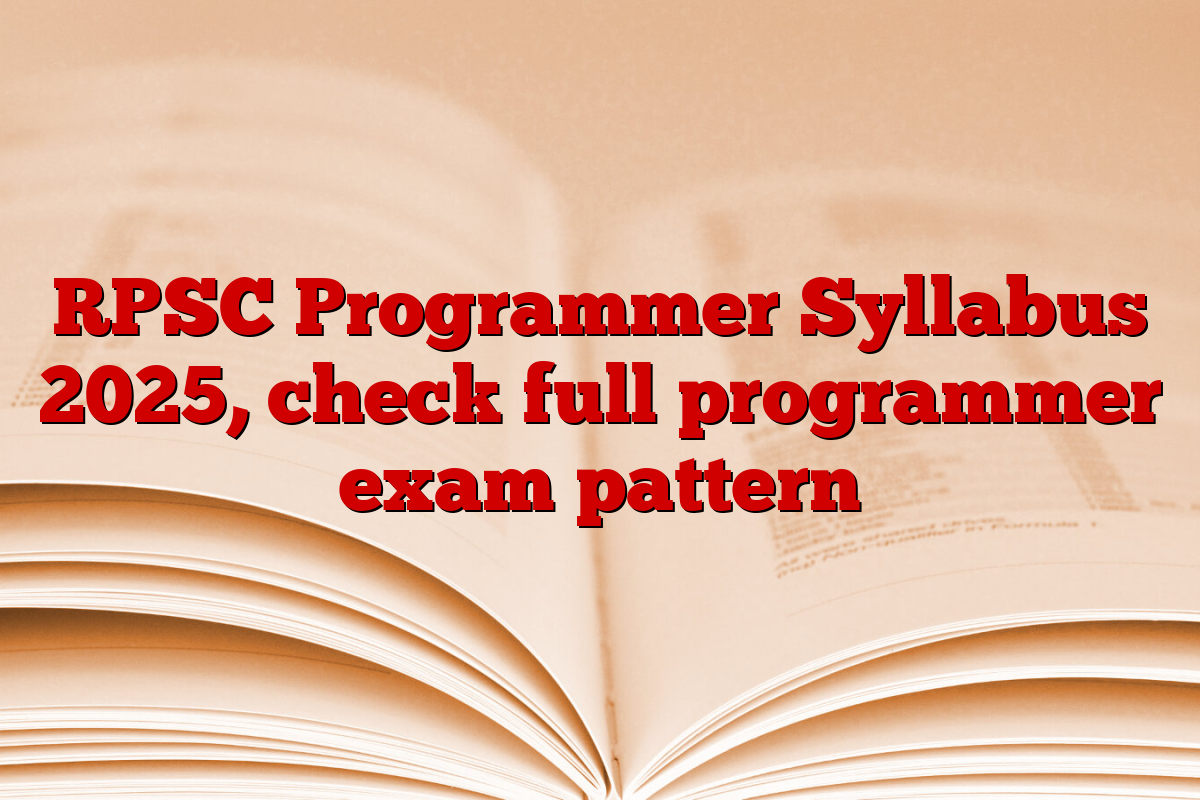The Rajasthan Public Service Commission (RPSC) has released the official notification for the posts of programmer on its official website @rpsc.rajasthan.gov.in. As it is a huge vacancy, candidates should only make a proper study plan from today according to RPSC Programmer Syllabus 2025. The article includes a detailed RPSC programmer syllabus and exam pattern 2025. Read the full article carefully and bookmark this website for the latest updates about engineering jobs.
RPSC Programmer Syllabus 2025 – Key Details
| RPSC Program Course 2025 | |
| Organization | Rajasthan Public Service Commission (RPSC) |
| designation | Programmer |
| Number of Vacancies | 352 |
| RPSC Programmer Exam Date | Be informed |
| RPSC Program Course | Available here |
| Selection process | Written test |
| official website | rpsc.rajasthan.gov.in |
RPSC Programmer Exam Pattern 2025
Rajasthan Public Service Commission (RPSC) will host Paper 1 and Paper 2 to select eligible candidates as Programmers. Important points related to RPSC programmer exam pattern 2025 are given below:
- The RPSC programmer exam will be conducted on the same day for both Paper 1 and Paper 2.
- RPSC Paper 1 and Paper 2 will have a total of 200 questions for each 1 digit.
- In both Paper 1 and Paper 2 respectively, a 2 -hour time period will be given to solve the questions.
| RPSC Programmer Exam Pattern 2025 | ||||
| paper | Subject name | Number of questions | Maximum marks | Time period |
| Paper 1 | logic | 100 | 100 | 2 hours |
| numerical analysis | ||||
| General knowledge | ||||
| Data base management system | ||||
| Data Communication Computer Network. | ||||
| Paper 2 |
System analysis and design (SAD) |
100 |
100 | 2 hours |
|
Programming concepts |
||||
RPSC Program Course 2025 Detailed
Rajasthan Public Service Commission (RPSC) will conduct the written examination to select the candidates as a programmer. Candidates should check the RPSC course and prepare each subject strictly. For the appropriate understanding of the candidates, a detailed RPSC programmer course in this article has been given 2025.
Courses for logic and numerical analysis
- problem solving.
- Data interpretation (DI).
- Data adequacy.
- Logical logic and analytical argument.
- General Knowledge and Current Affairs related to India and Rajasthan
Courses for data base management system (DBMS)
- ER diagrams, data models: Database, a relationship and object oriented database.
- Data Base Design: Conceptual database design.
- Normalization primitive and overall data types.
- Physical and logical databasadata concept of abstraction and data freedom, data aggregation and relational algebra.
- Application development using SQL: host language interfaces, embedded SQL programming, stored procedures and triggers and views, barriers.
- Interior of RDBMS: Physical data organization in sequential, indexed random and hashed files.
- Inverted and multilateral structures, B tree, B+ Trees, Querry Adaptation, Algorithm. Processing processing, consent control and recovery management.
- Lan -Deen Model Properties and State Stenorate.
- Lock base protocol, two-step locking.
Data communication courses for computer networks.
- Computer network architecture, circuit switching, packets and massage switching, network structure.
- Physical layer, data link layer, framing.
- Retransmission algorithm. Multiple Access and Aloha.
- CSMA/CD and Ethernet.
- High-speed lens and topology.
- Broadcast routing and spread trees.
- TCP/IP Stack.
- IP Network and Internet
- DNS and Firewall.
- Infiltration detection and prevention.
- Transport layer and TCP/IP.
- Network management and differences
Course for system analysis and design
- System concept: Definitions and characteristics, elements and boundaries, types of system development life cycle, recognition of requirements, feasibility studies, prototypeningrol of system analyst.
- System planning and tools such as DFDDATA dictionary, decision trees, structured analysis and decision table.
- IPO charts, structured walkthrough, input output form design, classification of requirements and forms, layout thought form control.
- Object Oriented Design Concepts and Methods.
- Software life cycle, software engineering paradigm.
- System Analysis: Pa Be facility study requirement analysis, cost advantage analysis, plan system, analysis equipment and technology.
- System Design: Design fundamental, modular design, data and procedural design, object oriented design.
- System Development: Code Document, Program Design Pratimulation, Efficiency Idea.
- Verification, verification and testing: methods of testing, formal program verification, test strategies.
- Software Maintenance: Maintenance features, stability, maintenance function and side effects.
Courses for programming concepts
- Introduction: Internet, Java Internet application, byte code and a tool for its advantages.
- Object Oriented Programming and Design: Review of abstract, objects, and other basics, encapsulation, information hiding, method, signature, classes and examples, polymorphism, heritage, exception, and exception handling object modeling, coupling and object-oriented software.
- Java programming basics: variable and assignment, input and output, data type and control expression, local variables, overloading parameters passing, ‘Point, Java Object Oriented Concepts File of I/O, Output with Stream Functions, Monitor I/O, Inheritance, Public and Private. Functions, arguments, wires, multidimensional arrays, strings’ arrays, vectors, base classes. For JSP, RMI, Java Applets and Sarvlets.
- Introduction to Dotet Framework and Visual Programming Interface.
sharing is Caring!
